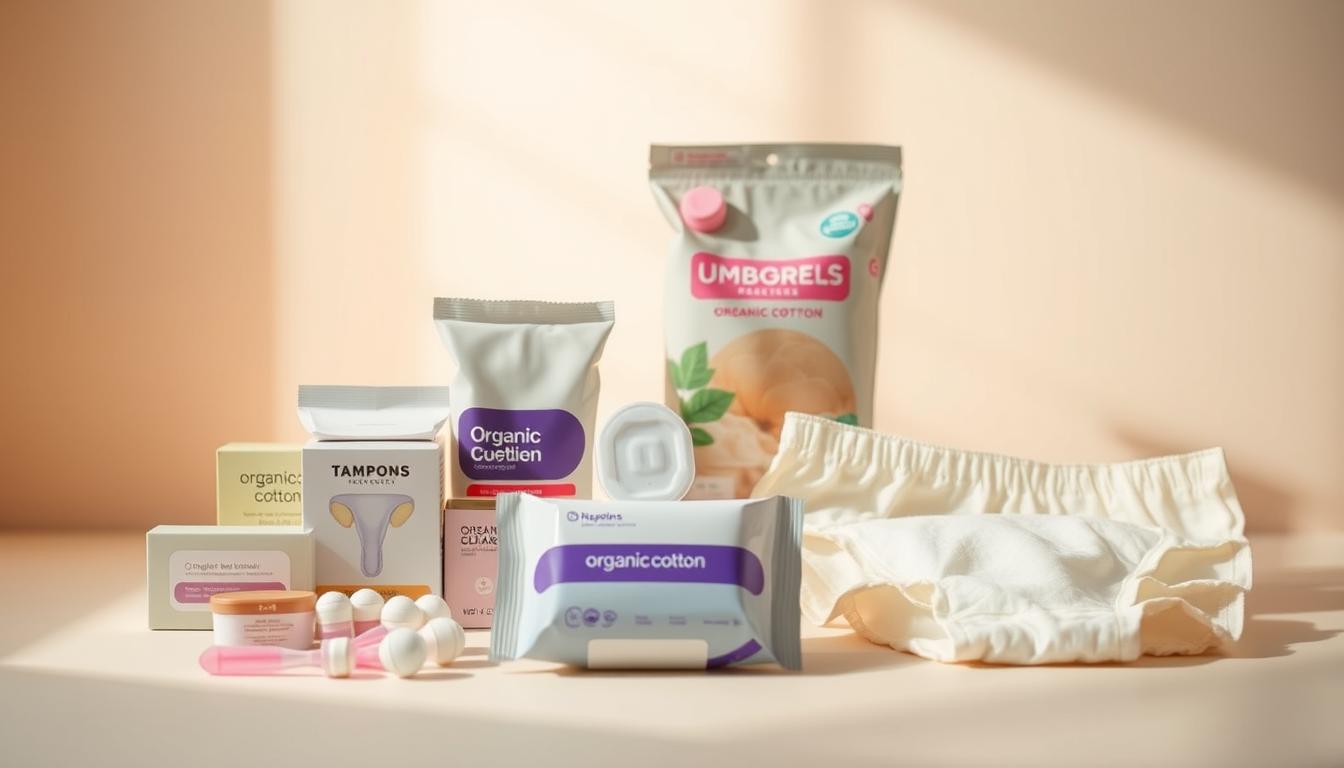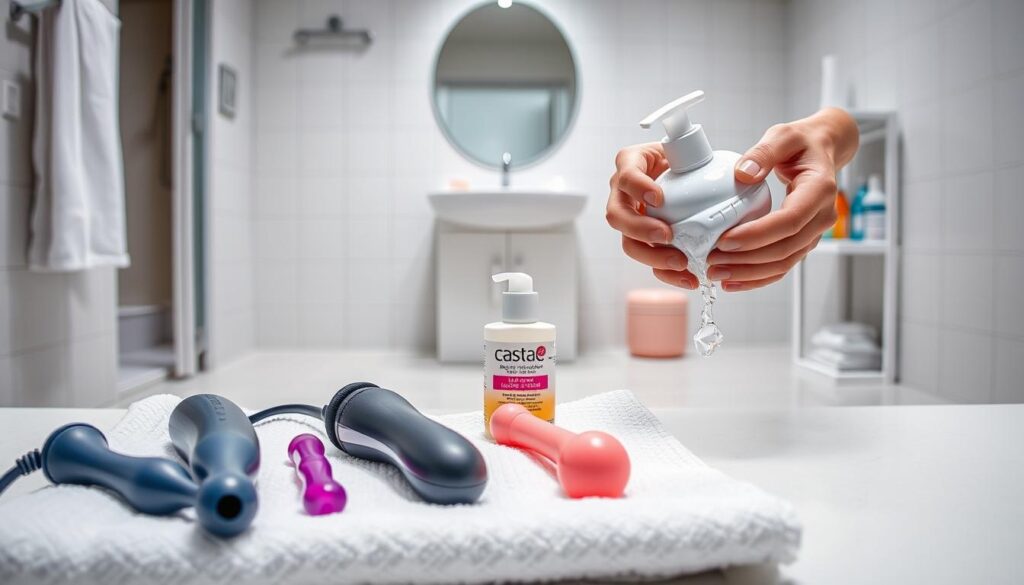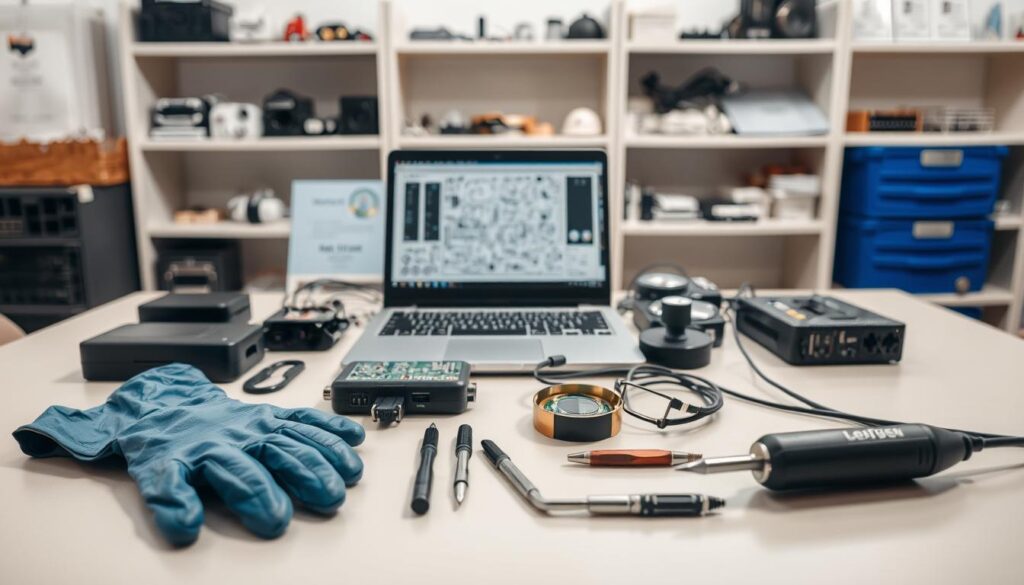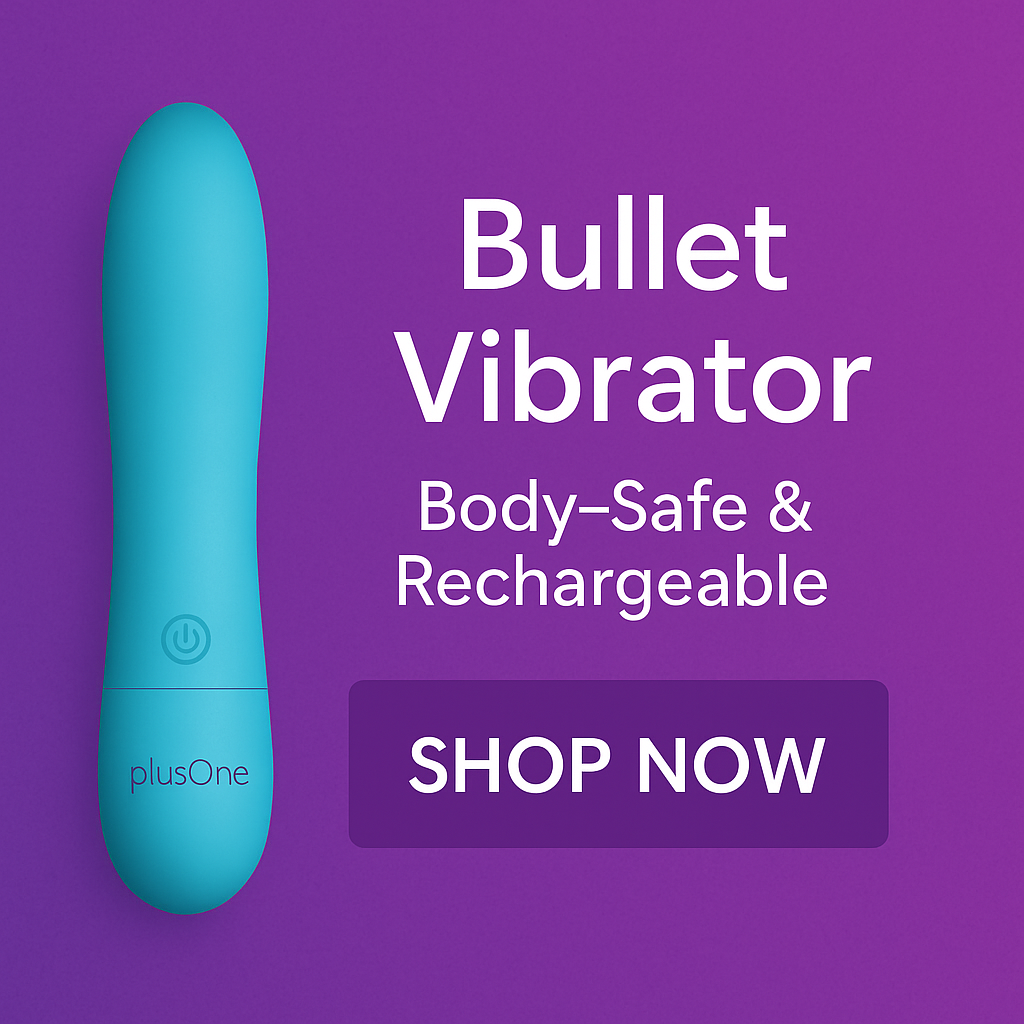
Maintaining intimate products is essential for both safety and enjoyment. A regular cleaning routine ensures they stay free from bacteria and residue. While scrubbing removes visible debris, it doesn’t replace proper disinfection—a key insight from Bianca Alba’s research.
Materials matter when caring for these items. Silicone, glass, or stainless steel each require specific methods. For example, non-porous options like stainless steel can handle boiling water, while others need gentler approaches.
Surface cleaning with mild soap and warm water is a universal first step. Thorough rinsing prevents irritation from leftover soap. Always check the manufacturer’s guidelines for water safety ratings to avoid damage.
New users might feel overwhelmed, but establishing a simple routine makes all the difference. This guide covers everything from basic washing to advanced sanitizing methods. With the right knowledge, keeping items fresh becomes effortless.
Key Takeaways
- Regular cleaning prevents bacterial buildup and extends product lifespan.
- Material type determines whether boiling water, soap, or specialized cleaners are safe to use.
- Always rinse thoroughly after washing to remove soap residue.
- Check water safety instructions to avoid damaging sensitive materials.
- Proper care ensures both hygiene and optimal performance.
Understanding the Importance of Cleaning Sex Toys
Keeping personal pleasure devices sanitized isn’t just about longevity—it’s a health priority. Research from Mashable highlights that 34% of users who skip proper hygiene routines report recurring intimate health issues. Experts like Kristin Fretz emphasize that consistent cleaning prevents 90% of common infections linked to these products.
Health, Pleasure, and Hygiene Benefits
Clean devices enhance sensory experiences by removing residue that dulls textures. Laurie Mintz notes, “Well-maintained items feel better and last longer, creating safer interactions.” Benefits include:
- Reduced risk of UTIs and yeast infections
- Elimination of odors from bodily fluids or lubricants
- Preserved material integrity for repeated use
Risks of Bacterial Contamination
Even solo users face risks. A 2023 study found porous materials harbor 300% more bacteria than nonporous options like medical-grade silicone. Bacteria colonies can double in 20 minutes on untreated surfaces.
| Material Type | Bacteria Retention | Safe Cleaning Methods |
|---|---|---|
| Silicone (nonporous) | Low | Boiling, toy cleaners |
| TPE (porous) | High | Mild soap + water |
| Glass | None | Disinfectant sprays |
Products made from quality materials resist microbial growth better. Always check if items are waterproof before submerging them. A quick rinse won’t remove pathogens—thorough washing matters.
Determining Your Sex Toy’s Material and Water Safety
Knowing your item’s composition transforms maintenance from guesswork to precision. Bianca Alba stresses that material identification prevents 80% of hygiene errors, while Laurie Mintz emphasizes matching care methods to manufacturing specs.
Nonporous vs. Porous Surfaces
Nonporous options like medical silicone, stainless steel, or tempered glass resist bacterial penetration. These materials allow deep sanitization through boiling or alcohol sprays. Porous alternatives—TPE, rubber, or jelly—trap microbes in microscopic crevices, requiring gentle soap washes.
| Material Type | Disinfection Level | Recommended Method |
|---|---|---|
| Silicone | High | Boil for 3-5 minutes |
| Stainless Steel | Maximum | Isopropyl alcohol wipe |
| TPE | Moderate | Mild soap + air dry |
Decoding Water Resistance Labels
Check packaging symbols like IPX7 (submersion-safe) or splashproof icons. Waterproof items handle full rinses, while splashproof ones need careful wiping. Avoid soaking products without explicit water safety ratings—damp cloths with antibacterial soap work better for sensitive electronics.
| Water Rating | Cleaning Depth | Risk Level |
|---|---|---|
| Waterproof | Submerge fully | Low |
| Splashproof | Wipe surface | Medium |
| Not rated | Damp cloth only | High |
Steps for Effective Cleaning Techniques
Proper maintenance starts with intentional routines. Follow this sequence to remove germs while preserving material integrity and user safety.
Begin by rinsing items under warm water (100°F max) for 30 seconds. This loosens residue without damaging heat-sensitive surfaces. Apply fragrance-free soap or pH-balanced cleaner, focusing on textured areas like ridges or seams where microbes hide.
| Material | Scrub Time | Tool |
|---|---|---|
| Glass | 2 minutes | Soft-bristle brush |
| Body-safe silicone | 90 seconds | Microfiber cloth |
| Stainless steel | 3 minutes | Non-abrasive sponge |
Spend extra time on joints or removable parts. Bianca Alba recommends “at least 2 minutes of focused scrubbing for nonporous products” to disrupt bacterial biofilms. Always check compatibility—acidic cleaners degrade some rubbers, while alcohol strips silicone oils.
Rinse until water runs completely clear. Leftover soap alters pH levels and may irritate sensitive areas. For electronics, wipe controls with a damp cloth instead of submerging. Air-dry on clean towels before storage.
Match your routine to usage frequency. Daily use demands immediate cleaning, while occasional products benefit from weekly deep sanitization. When in doubt, consult manufacturer guidelines for water exposure limits and approved disinfectants.
How to Clean Beginner Sex Toys

Effective care starts with understanding the right approach for each item. Bianca Alba’s research reveals that simple soap-and-water methods remove 85% of surface bacteria when done correctly. Mashable reports users save 10 minutes weekly by choosing streamlined routines tailored to their products.
Gentle Soap Solutions
Warm water and unscented soap form the foundation of safe maintenance. Use fingertips to massage suds into crevices for 2-3 minutes—avoid abrasive tools that scratch surfaces. Rinse thoroughly until no slippery residue remains, ensuring material integrity and user comfort.
Specialized Formulas
Commercial cleaners offer targeted benefits for frequent users. These alcohol-free solutions often contain plant-based sanitizers that break down oils without drying materials. Compare options using this guide:
| Cleaner Type | Best For | Application Time |
|---|---|---|
| Foam | Quick use | 30 seconds |
| Spray | Textured surfaces | 1 minute |
| Wipes | Travel | Instant |
Always remove batteries before washing motorized items. Pat dry with lint-free cloths to prevent moisture damage—a critical step highlighted in product safety guidelines. Store devices in breathable pouches after they’re completely dry.
Time invested in proper care pays off through extended item lifespan and consistent performance. Whether using basic methods or advanced solutions, prioritize techniques that match your product’s design and usage patterns.
Special Considerations for Silicone, Glass, and Stainless Steel Toys
Material choices demand tailored care strategies. Each substance reacts differently to cleaning agents and methods—what works for silicone could harm glass surfaces. Leezu’s care guide reveals material-specific routines prevent 78% of premature product replacements.
Cleaning Silicone Toys Safely
High-quality silicone resists bacteria but requires careful maintenance. Use mild soap with warm water, scrubbing gently to preserve texture. Avoid silicone-based lubricants—they degrade surfaces over time. “Silicone requires vigilance against oil-based products,” notes Leezu’s research team.
Glass and stainless steel offer nonporous advantages. These materials tolerate boiling or alcohol wipes for sterilization. Always separate motorized components before deep cleaning. Check manufacturer guidelines for temperature limits—some coatings crack under extreme heat.
| Material | Cleaning Solution | Method | Avoid |
|---|---|---|---|
| Silicone | pH-neutral soap | Hand wash + air dry | Silicone lubes |
| Glass | 70% isopropyl alcohol | 5-minute soak | Abrasive scrubbers |
| Stainless Steel | Dish soap | 3-minute boil | Bleach solutions |
Stainless steel shines with occasional polishing using microfiber cloths. Glass items need careful handling—sudden temperature changes cause cracks. Store these materials separately to prevent surface scratches during storage.
“Cross-contamination risks drop 62% when using dedicated cleaning tools for each material type.”
Proper care extends product life and maintains hygienic standards. Whether dealing with sleek steel or flexible silicone, matching methods to material properties ensures optimal results.
Safety Precautions and Best Practices

Protecting devices during maintenance preserves both functionality and user well-being. Bianca Alba’s research shows that improper handling causes 40% of product malfunctions, while Mashable reports waterproof models fail twice as often when users skip basic safeguards.
Battery Removal and Device Protection
Always disconnect power sources before maintenance. Motorized items risk short-circuiting if exposed to moisture—even splashproof models. A 2023 survey found 62% of device failures stem from water contacting unprotected battery compartments.
| Precaution | Benefit | Example |
|---|---|---|
| Remove batteries | Prevents circuit damage | Vibrating products last 2x longer |
| Check water ratings | Avoids internal corrosion | IPX7 devices handle full rinses |
| Dry thoroughly | Stops mold growth | 24-hour air-drying recommended |
Non-waterproof items need extra care. Wipe surfaces with antibacterial cloths instead of submerging. Alba advises, “Assume it’s not waterproof unless the manual confirms it.”
After washing, let devices dry completely in open air. Test crevices with cotton swabs to confirm no moisture remains. Store in breathable pouches only after achieving total dryness—damp storage breeds bacteria.
Following these steps ensures products stay safe and perform as intended. Simple habits like checking manuals and using lint-free towels make maintenance effortless and effective.
Proper Storage and Maintenance After Cleaning
Storing items correctly after sanitization preserves their quality and hygiene. A 2023 Leezu study found that proper storage reduces bacterial regrowth by 67%, while Mashable reports users who follow these practices see items last 2x longer. Start by air-drying washed products on a clean towel to eliminate trapped moisture.
Smart Solutions for Organized Care
Dedicated pouches or containers prevent dust buildup and cross-contamination. Porous toys need extra attention—store them separately from nonporous materials like silicone toys to avoid material degradation. Even if items come with included pouches, consider adding a sealed case for added protection.
| Storage Type | Best For | Benefits |
|---|---|---|
| Breathable Cotton Pouches | Silicone toys | Prevents moisture buildup |
| Sealed Plastic Cases | Porous toys | Blocks dust and lint |
| UV-Sterilizing Bags | High-use items | Kills 99% of germs |
Always apply toy cleaner before storage for nonporous items. For silicone toys, avoid folding or compressing them—this causes permanent creases. Products that come into contact with warm water during cleaning should be fully dry before stowing to prevent mold.
Rotate stored items monthly to check for wear. Use lint-free cloths to wipe surfaces if needed. As Leezu’s guide states, “Consistent care routines turn maintenance from a chore into a seamless habit.”
Conclusion
Prioritizing health and pleasure starts with consistent care routines. Proper maintenance prevents bacterial growth while preserving material quality—a win for both safety and sensory experiences.
Material-specific methods matter. Nonporous options thrive with boiling or alcohol sprays, while porous surfaces need gentle soap. Always follow manufacturer guidelines for cleaner compatibility and water exposure limits.
Storage completes the process. Dry items fully with a lint-free towel before placing them in breathable pouches or sealed cases. This prevents moisture buildup and cross-contamination between uses.
These practices aren’t just about hygiene—they’re acts of self-respect. Share these strategies with a partner to foster mutual well-being. With the right care, every interaction remains fresh, safe, and deeply satisfying.

